Marketing Research Report: Value Proposition in UK Supermarkets
VerifiedAdded on 2023/01/23
|10
|2193
|42
Report
AI Summary
This marketing research report investigates the value proposition strategies employed by supermarkets in Southampton, UK, focusing on customer perceptions and preferences. The report begins with an executive summary, outlining the research's purpose, which is to understand how value is delivered and perceived in the supermarket context. The introduction emphasizes the importance of value proposition in marketing, particularly in the face of increasing competition. The research delves into customer value, management problems, and the significance of a compelling value proposition in attracting and retaining customers. Research questions address how customers perceive value generally and specifically across different supermarkets, with objectives to analyze these perceptions and identify any differences. A comprehensive literature review explores the concept of value proposition, marketing methodologies, and profiles of Asda, Waitrose, Sainsbury’s, and Tesco. The study uses an exploratory research design, which helps establish causal connections between variables. The report then provides detailed profiles of Asda, Tesco, Sainsbury's, and Waitrose, analyzing their value propositions and marketing strategies. The report concludes by emphasizing the importance of tailoring value propositions to meet diverse consumer needs and the crucial role of value in driving customer loyalty and business success. The report is a valuable resource for students seeking to understand marketing research and the practical application of value proposition concepts.

MARKETING RESEARCH 1
MARKETING RESEARCH
Name
Course
Tutor
University
City/State
Date
MARKETING RESEARCH
Name
Course
Tutor
University
City/State
Date
Paraphrase This Document
Need a fresh take? Get an instant paraphrase of this document with our AI Paraphraser
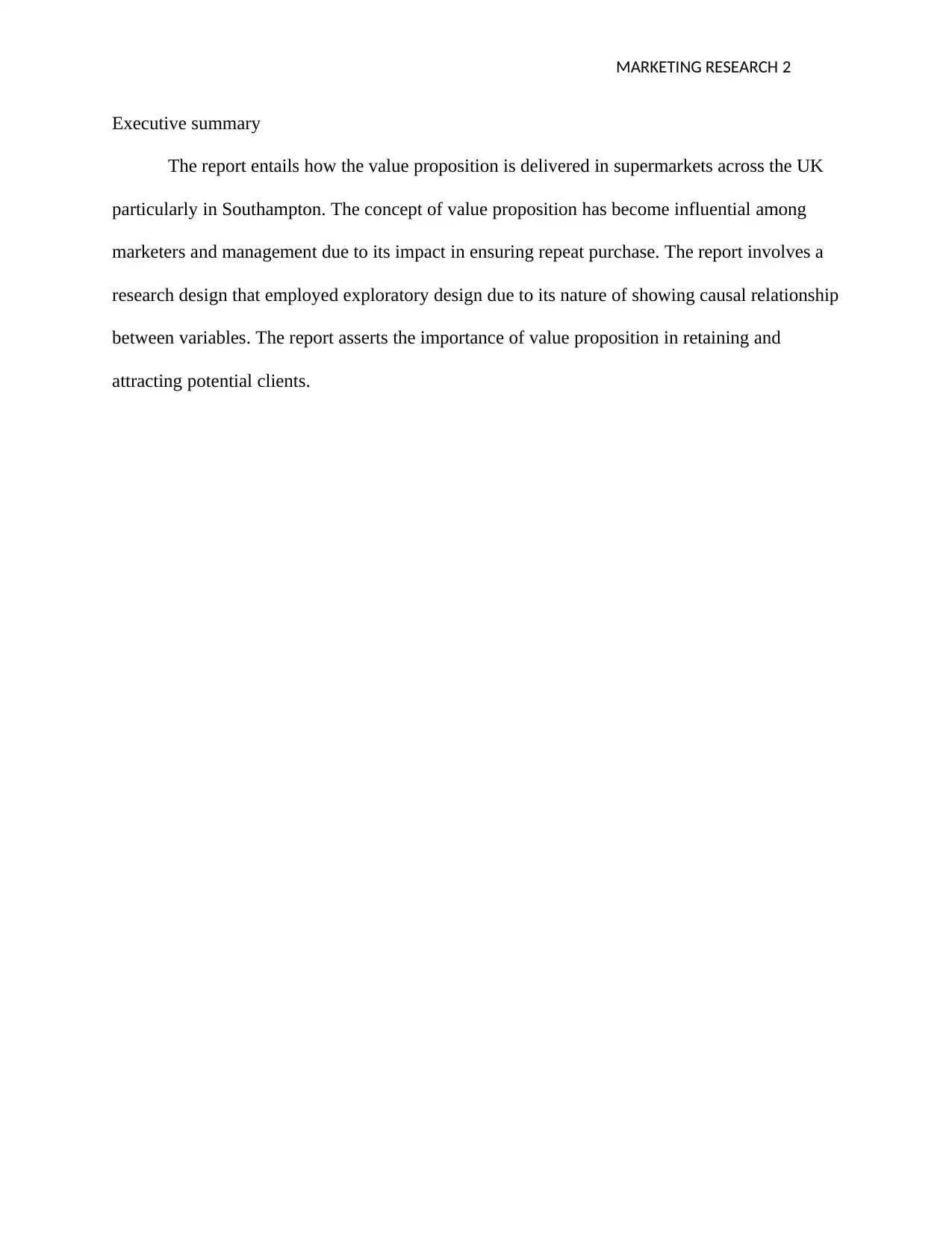
MARKETING RESEARCH 2
Executive summary
The report entails how the value proposition is delivered in supermarkets across the UK
particularly in Southampton. The concept of value proposition has become influential among
marketers and management due to its impact in ensuring repeat purchase. The report involves a
research design that employed exploratory design due to its nature of showing causal relationship
between variables. The report asserts the importance of value proposition in retaining and
attracting potential clients.
Executive summary
The report entails how the value proposition is delivered in supermarkets across the UK
particularly in Southampton. The concept of value proposition has become influential among
marketers and management due to its impact in ensuring repeat purchase. The report involves a
research design that employed exploratory design due to its nature of showing causal relationship
between variables. The report asserts the importance of value proposition in retaining and
attracting potential clients.
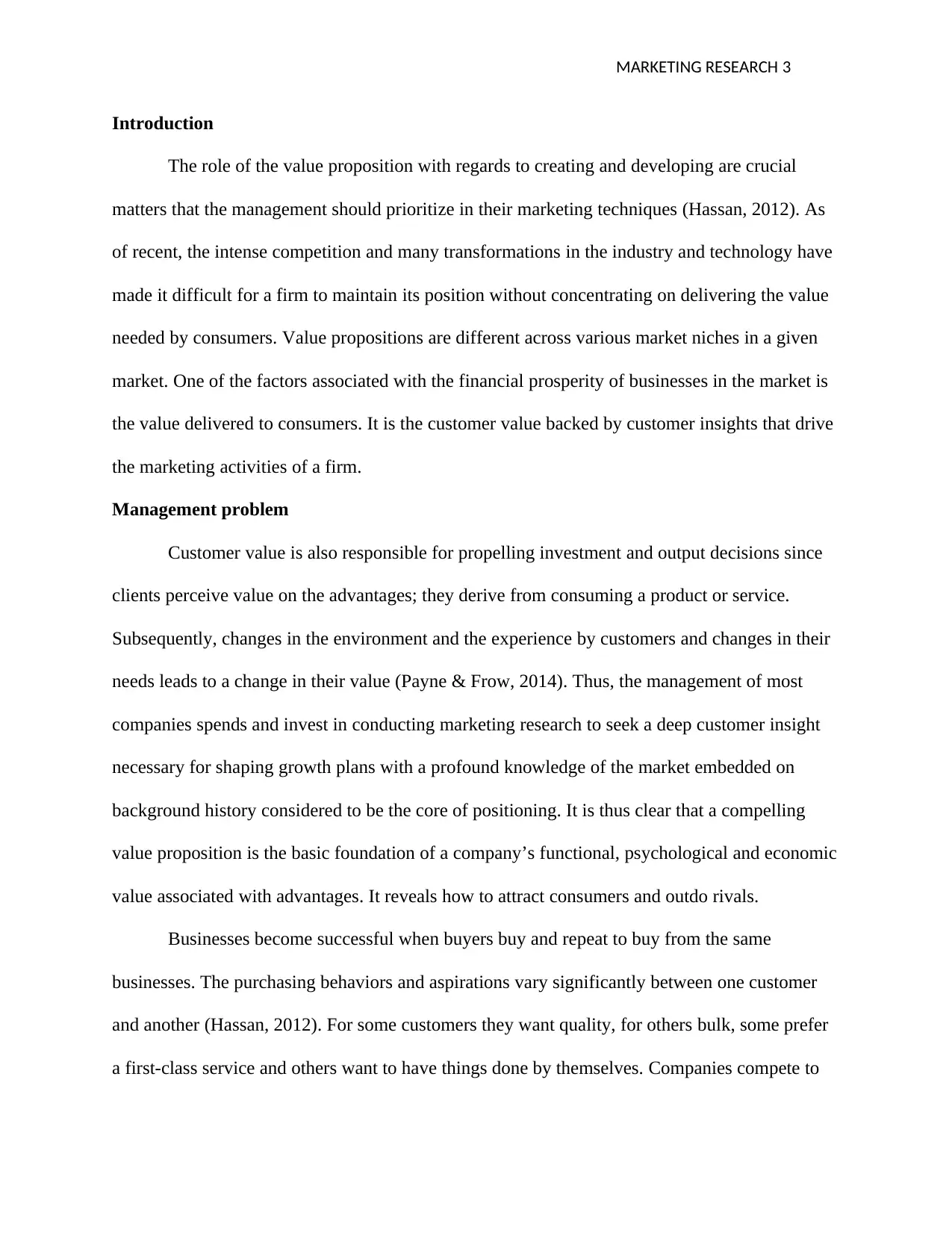
MARKETING RESEARCH 3
Introduction
The role of the value proposition with regards to creating and developing are crucial
matters that the management should prioritize in their marketing techniques (Hassan, 2012). As
of recent, the intense competition and many transformations in the industry and technology have
made it difficult for a firm to maintain its position without concentrating on delivering the value
needed by consumers. Value propositions are different across various market niches in a given
market. One of the factors associated with the financial prosperity of businesses in the market is
the value delivered to consumers. It is the customer value backed by customer insights that drive
the marketing activities of a firm.
Management problem
Customer value is also responsible for propelling investment and output decisions since
clients perceive value on the advantages; they derive from consuming a product or service.
Subsequently, changes in the environment and the experience by customers and changes in their
needs leads to a change in their value (Payne & Frow, 2014). Thus, the management of most
companies spends and invest in conducting marketing research to seek a deep customer insight
necessary for shaping growth plans with a profound knowledge of the market embedded on
background history considered to be the core of positioning. It is thus clear that a compelling
value proposition is the basic foundation of a company’s functional, psychological and economic
value associated with advantages. It reveals how to attract consumers and outdo rivals.
Businesses become successful when buyers buy and repeat to buy from the same
businesses. The purchasing behaviors and aspirations vary significantly between one customer
and another (Hassan, 2012). For some customers they want quality, for others bulk, some prefer
a first-class service and others want to have things done by themselves. Companies compete to
Introduction
The role of the value proposition with regards to creating and developing are crucial
matters that the management should prioritize in their marketing techniques (Hassan, 2012). As
of recent, the intense competition and many transformations in the industry and technology have
made it difficult for a firm to maintain its position without concentrating on delivering the value
needed by consumers. Value propositions are different across various market niches in a given
market. One of the factors associated with the financial prosperity of businesses in the market is
the value delivered to consumers. It is the customer value backed by customer insights that drive
the marketing activities of a firm.
Management problem
Customer value is also responsible for propelling investment and output decisions since
clients perceive value on the advantages; they derive from consuming a product or service.
Subsequently, changes in the environment and the experience by customers and changes in their
needs leads to a change in their value (Payne & Frow, 2014). Thus, the management of most
companies spends and invest in conducting marketing research to seek a deep customer insight
necessary for shaping growth plans with a profound knowledge of the market embedded on
background history considered to be the core of positioning. It is thus clear that a compelling
value proposition is the basic foundation of a company’s functional, psychological and economic
value associated with advantages. It reveals how to attract consumers and outdo rivals.
Businesses become successful when buyers buy and repeat to buy from the same
businesses. The purchasing behaviors and aspirations vary significantly between one customer
and another (Hassan, 2012). For some customers they want quality, for others bulk, some prefer
a first-class service and others want to have things done by themselves. Companies compete to
⊘ This is a preview!⊘
Do you want full access?
Subscribe today to unlock all pages.

Trusted by 1+ million students worldwide
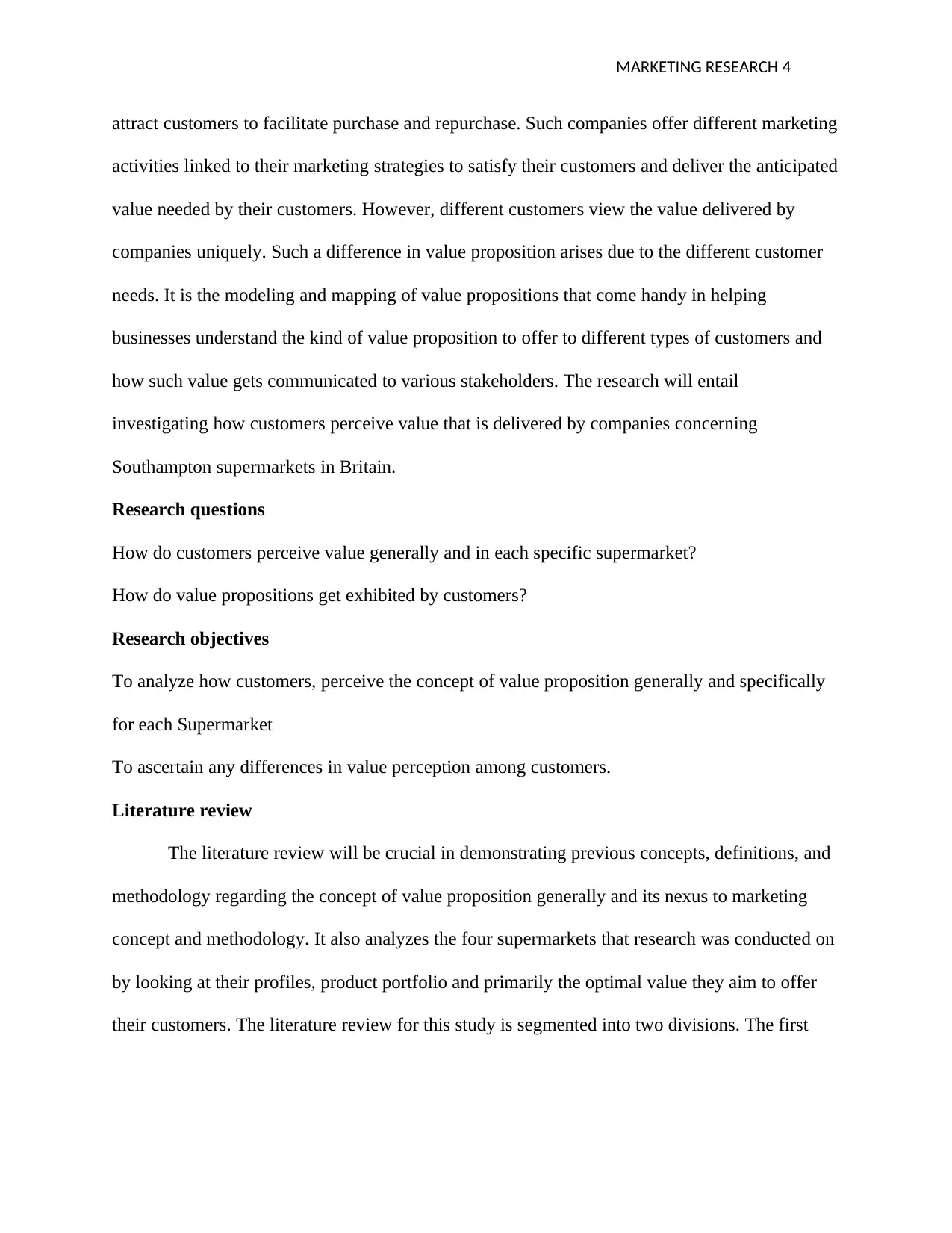
MARKETING RESEARCH 4
attract customers to facilitate purchase and repurchase. Such companies offer different marketing
activities linked to their marketing strategies to satisfy their customers and deliver the anticipated
value needed by their customers. However, different customers view the value delivered by
companies uniquely. Such a difference in value proposition arises due to the different customer
needs. It is the modeling and mapping of value propositions that come handy in helping
businesses understand the kind of value proposition to offer to different types of customers and
how such value gets communicated to various stakeholders. The research will entail
investigating how customers perceive value that is delivered by companies concerning
Southampton supermarkets in Britain.
Research questions
How do customers perceive value generally and in each specific supermarket?
How do value propositions get exhibited by customers?
Research objectives
To analyze how customers, perceive the concept of value proposition generally and specifically
for each Supermarket
To ascertain any differences in value perception among customers.
Literature review
The literature review will be crucial in demonstrating previous concepts, definitions, and
methodology regarding the concept of value proposition generally and its nexus to marketing
concept and methodology. It also analyzes the four supermarkets that research was conducted on
by looking at their profiles, product portfolio and primarily the optimal value they aim to offer
their customers. The literature review for this study is segmented into two divisions. The first
attract customers to facilitate purchase and repurchase. Such companies offer different marketing
activities linked to their marketing strategies to satisfy their customers and deliver the anticipated
value needed by their customers. However, different customers view the value delivered by
companies uniquely. Such a difference in value proposition arises due to the different customer
needs. It is the modeling and mapping of value propositions that come handy in helping
businesses understand the kind of value proposition to offer to different types of customers and
how such value gets communicated to various stakeholders. The research will entail
investigating how customers perceive value that is delivered by companies concerning
Southampton supermarkets in Britain.
Research questions
How do customers perceive value generally and in each specific supermarket?
How do value propositions get exhibited by customers?
Research objectives
To analyze how customers, perceive the concept of value proposition generally and specifically
for each Supermarket
To ascertain any differences in value perception among customers.
Literature review
The literature review will be crucial in demonstrating previous concepts, definitions, and
methodology regarding the concept of value proposition generally and its nexus to marketing
concept and methodology. It also analyzes the four supermarkets that research was conducted on
by looking at their profiles, product portfolio and primarily the optimal value they aim to offer
their customers. The literature review for this study is segmented into two divisions. The first
Paraphrase This Document
Need a fresh take? Get an instant paraphrase of this document with our AI Paraphraser
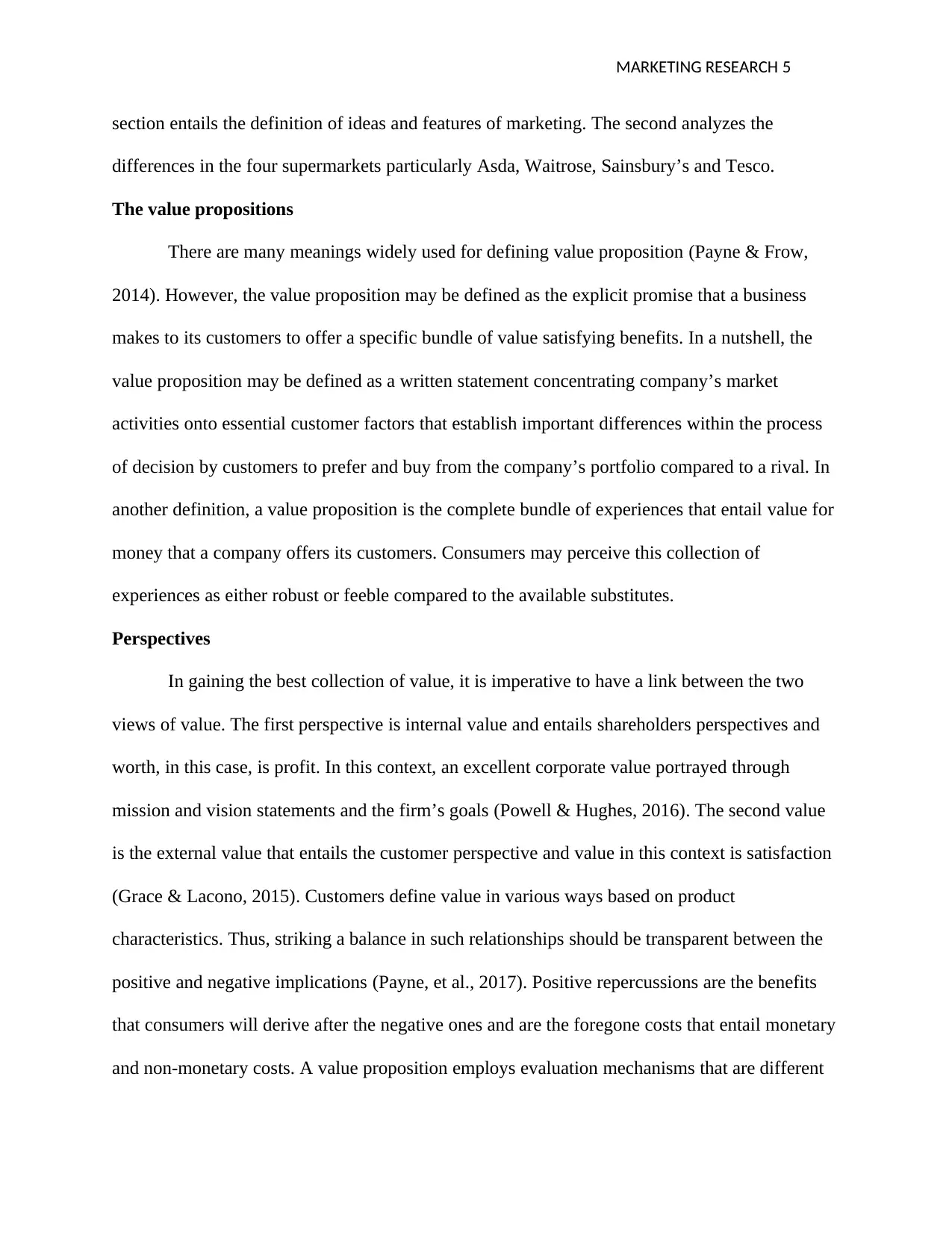
MARKETING RESEARCH 5
section entails the definition of ideas and features of marketing. The second analyzes the
differences in the four supermarkets particularly Asda, Waitrose, Sainsbury’s and Tesco.
The value propositions
There are many meanings widely used for defining value proposition (Payne & Frow,
2014). However, the value proposition may be defined as the explicit promise that a business
makes to its customers to offer a specific bundle of value satisfying benefits. In a nutshell, the
value proposition may be defined as a written statement concentrating company’s market
activities onto essential customer factors that establish important differences within the process
of decision by customers to prefer and buy from the company’s portfolio compared to a rival. In
another definition, a value proposition is the complete bundle of experiences that entail value for
money that a company offers its customers. Consumers may perceive this collection of
experiences as either robust or feeble compared to the available substitutes.
Perspectives
In gaining the best collection of value, it is imperative to have a link between the two
views of value. The first perspective is internal value and entails shareholders perspectives and
worth, in this case, is profit. In this context, an excellent corporate value portrayed through
mission and vision statements and the firm’s goals (Powell & Hughes, 2016). The second value
is the external value that entails the customer perspective and value in this context is satisfaction
(Grace & Lacono, 2015). Customers define value in various ways based on product
characteristics. Thus, striking a balance in such relationships should be transparent between the
positive and negative implications (Payne, et al., 2017). Positive repercussions are the benefits
that consumers will derive after the negative ones and are the foregone costs that entail monetary
and non-monetary costs. A value proposition employs evaluation mechanisms that are different
section entails the definition of ideas and features of marketing. The second analyzes the
differences in the four supermarkets particularly Asda, Waitrose, Sainsbury’s and Tesco.
The value propositions
There are many meanings widely used for defining value proposition (Payne & Frow,
2014). However, the value proposition may be defined as the explicit promise that a business
makes to its customers to offer a specific bundle of value satisfying benefits. In a nutshell, the
value proposition may be defined as a written statement concentrating company’s market
activities onto essential customer factors that establish important differences within the process
of decision by customers to prefer and buy from the company’s portfolio compared to a rival. In
another definition, a value proposition is the complete bundle of experiences that entail value for
money that a company offers its customers. Consumers may perceive this collection of
experiences as either robust or feeble compared to the available substitutes.
Perspectives
In gaining the best collection of value, it is imperative to have a link between the two
views of value. The first perspective is internal value and entails shareholders perspectives and
worth, in this case, is profit. In this context, an excellent corporate value portrayed through
mission and vision statements and the firm’s goals (Powell & Hughes, 2016). The second value
is the external value that entails the customer perspective and value in this context is satisfaction
(Grace & Lacono, 2015). Customers define value in various ways based on product
characteristics. Thus, striking a balance in such relationships should be transparent between the
positive and negative implications (Payne, et al., 2017). Positive repercussions are the benefits
that consumers will derive after the negative ones and are the foregone costs that entail monetary
and non-monetary costs. A value proposition employs evaluation mechanisms that are different
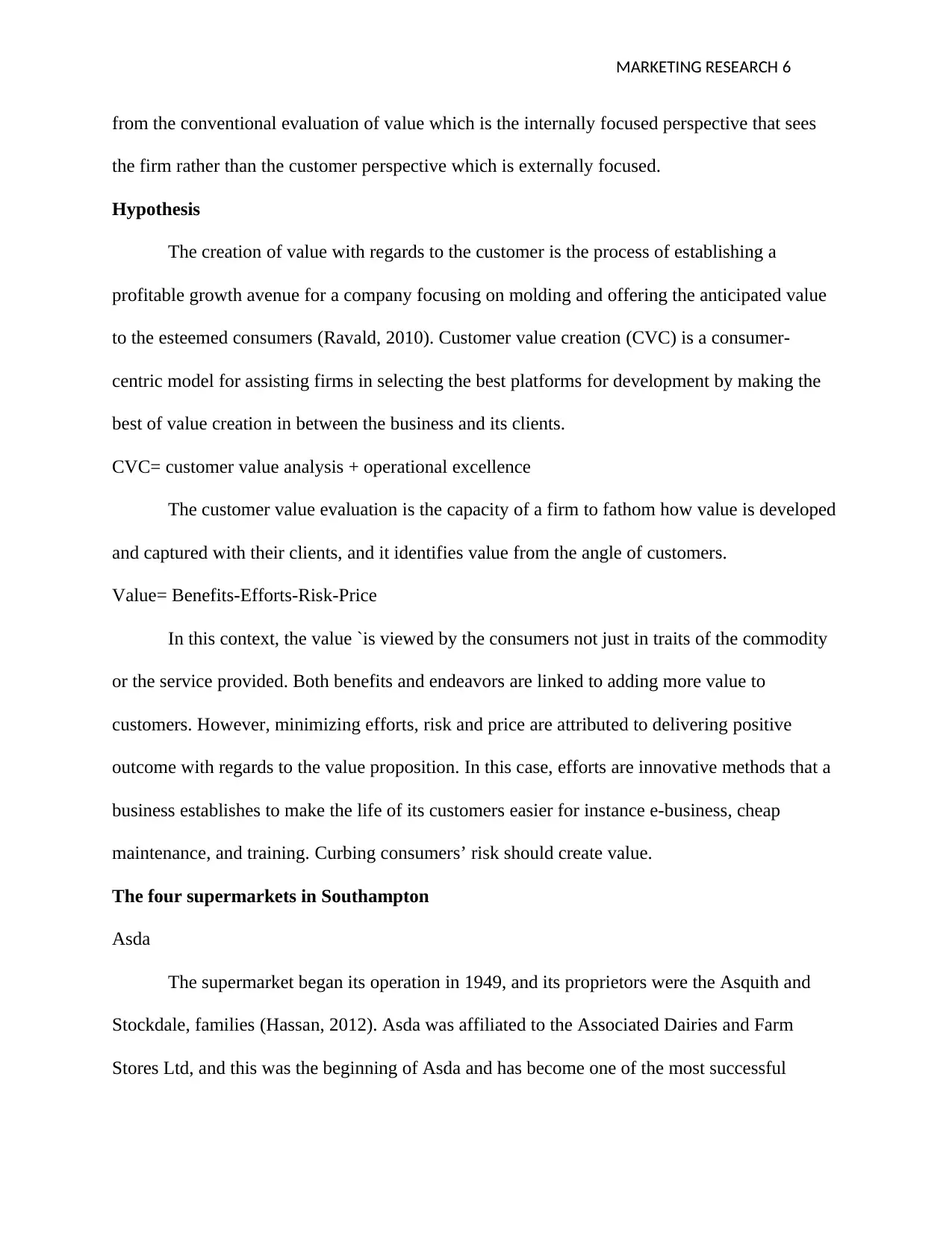
MARKETING RESEARCH 6
from the conventional evaluation of value which is the internally focused perspective that sees
the firm rather than the customer perspective which is externally focused.
Hypothesis
The creation of value with regards to the customer is the process of establishing a
profitable growth avenue for a company focusing on molding and offering the anticipated value
to the esteemed consumers (Ravald, 2010). Customer value creation (CVC) is a consumer-
centric model for assisting firms in selecting the best platforms for development by making the
best of value creation in between the business and its clients.
CVC= customer value analysis + operational excellence
The customer value evaluation is the capacity of a firm to fathom how value is developed
and captured with their clients, and it identifies value from the angle of customers.
Value= Benefits-Efforts-Risk-Price
In this context, the value `is viewed by the consumers not just in traits of the commodity
or the service provided. Both benefits and endeavors are linked to adding more value to
customers. However, minimizing efforts, risk and price are attributed to delivering positive
outcome with regards to the value proposition. In this case, efforts are innovative methods that a
business establishes to make the life of its customers easier for instance e-business, cheap
maintenance, and training. Curbing consumers’ risk should create value.
The four supermarkets in Southampton
Asda
The supermarket began its operation in 1949, and its proprietors were the Asquith and
Stockdale, families (Hassan, 2012). Asda was affiliated to the Associated Dairies and Farm
Stores Ltd, and this was the beginning of Asda and has become one of the most successful
from the conventional evaluation of value which is the internally focused perspective that sees
the firm rather than the customer perspective which is externally focused.
Hypothesis
The creation of value with regards to the customer is the process of establishing a
profitable growth avenue for a company focusing on molding and offering the anticipated value
to the esteemed consumers (Ravald, 2010). Customer value creation (CVC) is a consumer-
centric model for assisting firms in selecting the best platforms for development by making the
best of value creation in between the business and its clients.
CVC= customer value analysis + operational excellence
The customer value evaluation is the capacity of a firm to fathom how value is developed
and captured with their clients, and it identifies value from the angle of customers.
Value= Benefits-Efforts-Risk-Price
In this context, the value `is viewed by the consumers not just in traits of the commodity
or the service provided. Both benefits and endeavors are linked to adding more value to
customers. However, minimizing efforts, risk and price are attributed to delivering positive
outcome with regards to the value proposition. In this case, efforts are innovative methods that a
business establishes to make the life of its customers easier for instance e-business, cheap
maintenance, and training. Curbing consumers’ risk should create value.
The four supermarkets in Southampton
Asda
The supermarket began its operation in 1949, and its proprietors were the Asquith and
Stockdale, families (Hassan, 2012). Asda was affiliated to the Associated Dairies and Farm
Stores Ltd, and this was the beginning of Asda and has become one of the most successful
⊘ This is a preview!⊘
Do you want full access?
Subscribe today to unlock all pages.

Trusted by 1+ million students worldwide

MARKETING RESEARCH 7
supermarkets in the past six decades. Asda also became part of Wal-Mart which had been ranked
as one of the largest and best retailers across the globe. Asda is rated as the second-best
supermarket in the UK based on its terms of sales. Asda runs an essential core value statement
that it communicates to its customers that is “saving you money every day”. Asda’s value
proposition is delivering products to its customers at the lowest price possible. Also, the
supermarkets aim at widening the competition gap between it and its rival supermarkets.
Tesco
Tesco came to the limelight due to the popularity of its loyalty card campaign and led to
the supermarket being awarded as the most successful company in establishing the loyalty card
scheme (Hassan, 2012). One advantage of the loyalty card is that it provides a clue on what
customers like to purchase. The value proposition by Tesco is according to its customers any
help and effort. Tesco runs a statement that states “every little help.”
Sainsbury’s
Sainsbury’s has a strong dedication to its customers and suppliers and has a robust
perspective on business ethics. The supermarket over the years has developed a passion for
charging fair prices for its food commodities and has dedicated its effort in delivering value to its
customers. The supermarket has been in business for more than 140 years offering customers the
value they seek. The supermarket has a market share of more than 16% serving more than 60
million customers monthly (Hassan, 2012).
Waitrose
Waitrose has more than 200 stores and has in business for more than 100 years. Waitrose
has been recognized as one top grocery stores in the UK (Hassan, 2012). Waitrose’s business
model is based on offering customers with a fantastic experience in their shopping experience
supermarkets in the past six decades. Asda also became part of Wal-Mart which had been ranked
as one of the largest and best retailers across the globe. Asda is rated as the second-best
supermarket in the UK based on its terms of sales. Asda runs an essential core value statement
that it communicates to its customers that is “saving you money every day”. Asda’s value
proposition is delivering products to its customers at the lowest price possible. Also, the
supermarkets aim at widening the competition gap between it and its rival supermarkets.
Tesco
Tesco came to the limelight due to the popularity of its loyalty card campaign and led to
the supermarket being awarded as the most successful company in establishing the loyalty card
scheme (Hassan, 2012). One advantage of the loyalty card is that it provides a clue on what
customers like to purchase. The value proposition by Tesco is according to its customers any
help and effort. Tesco runs a statement that states “every little help.”
Sainsbury’s
Sainsbury’s has a strong dedication to its customers and suppliers and has a robust
perspective on business ethics. The supermarket over the years has developed a passion for
charging fair prices for its food commodities and has dedicated its effort in delivering value to its
customers. The supermarket has been in business for more than 140 years offering customers the
value they seek. The supermarket has a market share of more than 16% serving more than 60
million customers monthly (Hassan, 2012).
Waitrose
Waitrose has more than 200 stores and has in business for more than 100 years. Waitrose
has been recognized as one top grocery stores in the UK (Hassan, 2012). Waitrose’s business
model is based on offering customers with a fantastic experience in their shopping experience
Paraphrase This Document
Need a fresh take? Get an instant paraphrase of this document with our AI Paraphraser
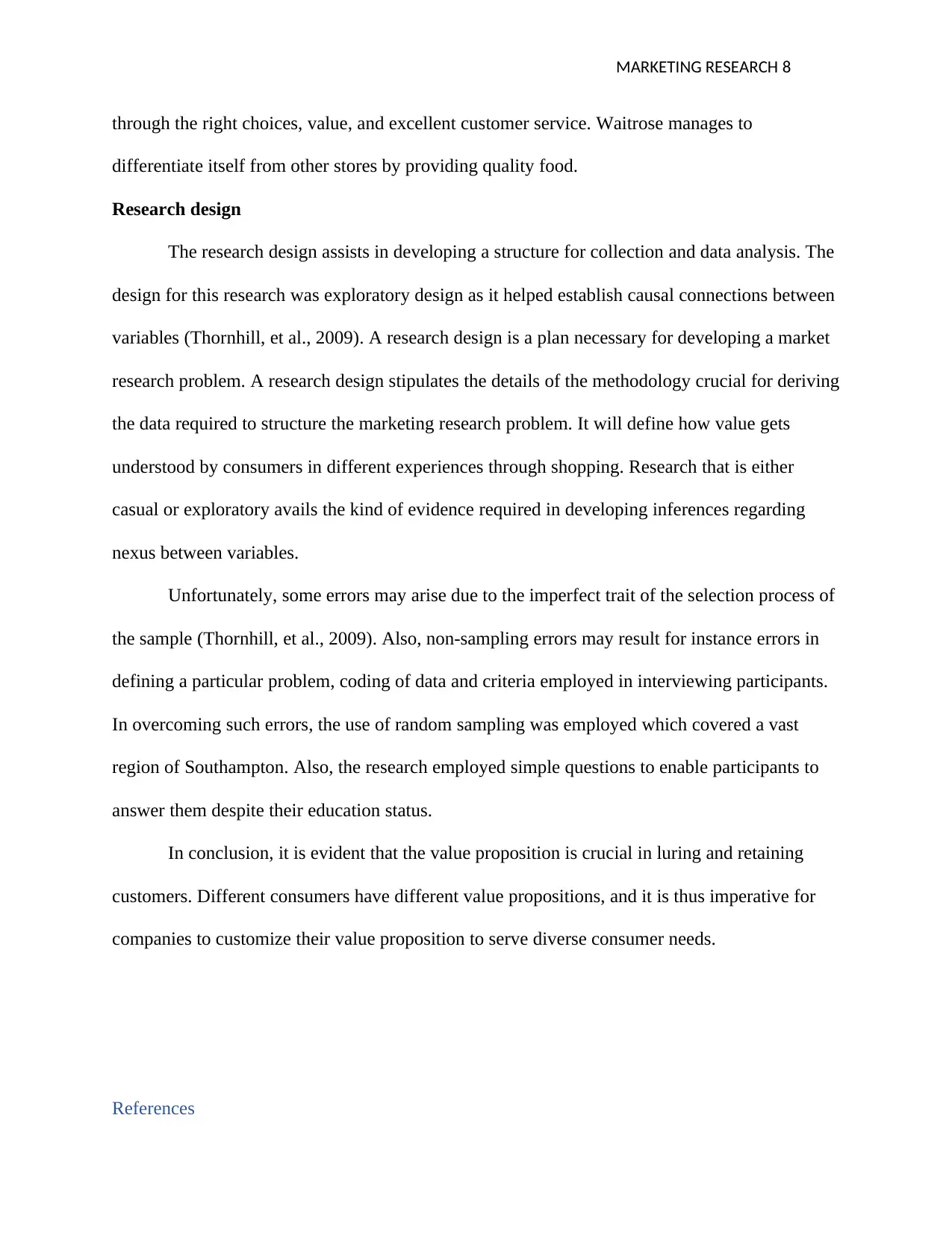
MARKETING RESEARCH 8
through the right choices, value, and excellent customer service. Waitrose manages to
differentiate itself from other stores by providing quality food.
Research design
The research design assists in developing a structure for collection and data analysis. The
design for this research was exploratory design as it helped establish causal connections between
variables (Thornhill, et al., 2009). A research design is a plan necessary for developing a market
research problem. A research design stipulates the details of the methodology crucial for deriving
the data required to structure the marketing research problem. It will define how value gets
understood by consumers in different experiences through shopping. Research that is either
casual or exploratory avails the kind of evidence required in developing inferences regarding
nexus between variables.
Unfortunately, some errors may arise due to the imperfect trait of the selection process of
the sample (Thornhill, et al., 2009). Also, non-sampling errors may result for instance errors in
defining a particular problem, coding of data and criteria employed in interviewing participants.
In overcoming such errors, the use of random sampling was employed which covered a vast
region of Southampton. Also, the research employed simple questions to enable participants to
answer them despite their education status.
In conclusion, it is evident that the value proposition is crucial in luring and retaining
customers. Different consumers have different value propositions, and it is thus imperative for
companies to customize their value proposition to serve diverse consumer needs.
References
through the right choices, value, and excellent customer service. Waitrose manages to
differentiate itself from other stores by providing quality food.
Research design
The research design assists in developing a structure for collection and data analysis. The
design for this research was exploratory design as it helped establish causal connections between
variables (Thornhill, et al., 2009). A research design is a plan necessary for developing a market
research problem. A research design stipulates the details of the methodology crucial for deriving
the data required to structure the marketing research problem. It will define how value gets
understood by consumers in different experiences through shopping. Research that is either
casual or exploratory avails the kind of evidence required in developing inferences regarding
nexus between variables.
Unfortunately, some errors may arise due to the imperfect trait of the selection process of
the sample (Thornhill, et al., 2009). Also, non-sampling errors may result for instance errors in
defining a particular problem, coding of data and criteria employed in interviewing participants.
In overcoming such errors, the use of random sampling was employed which covered a vast
region of Southampton. Also, the research employed simple questions to enable participants to
answer them despite their education status.
In conclusion, it is evident that the value proposition is crucial in luring and retaining
customers. Different consumers have different value propositions, and it is thus imperative for
companies to customize their value proposition to serve diverse consumer needs.
References
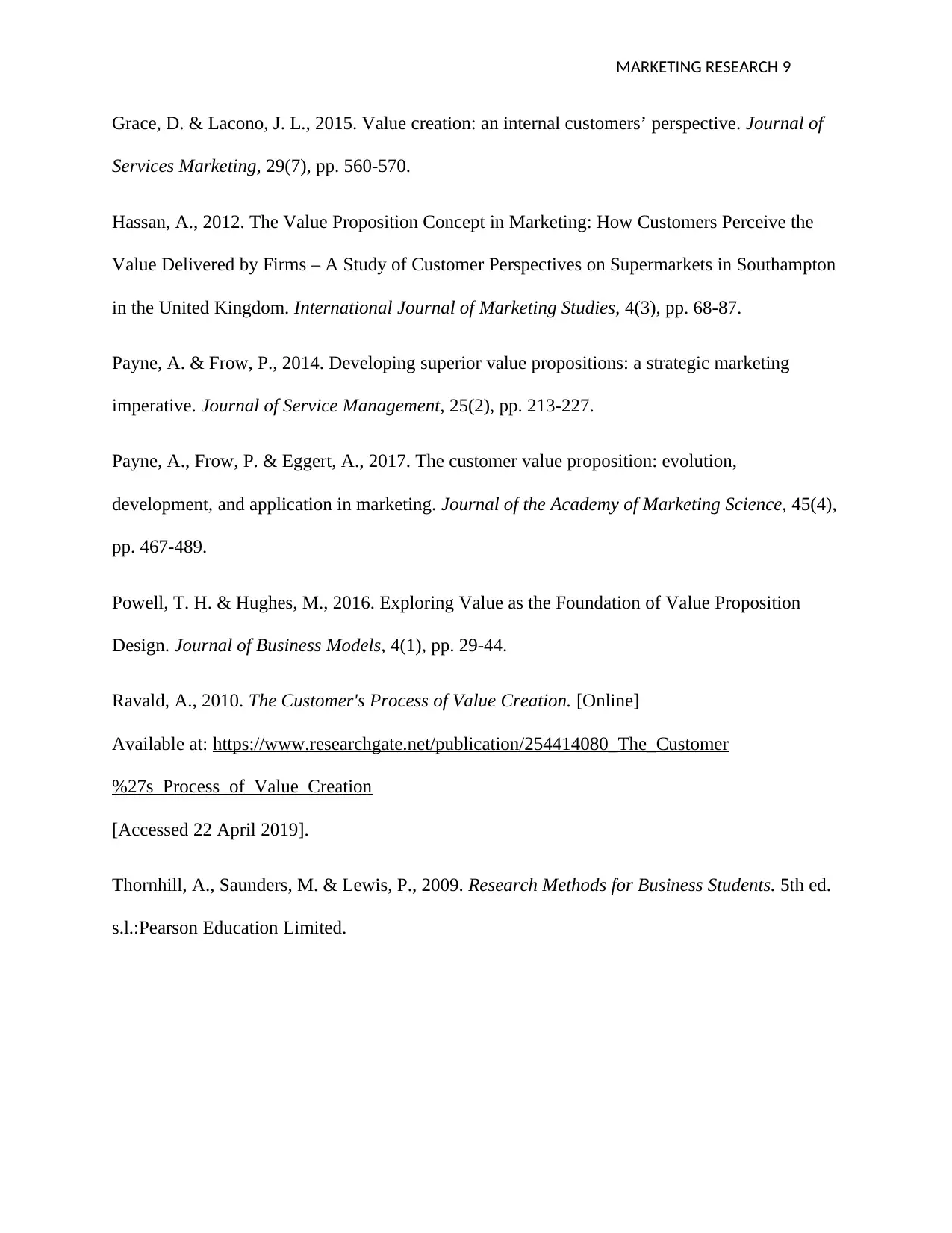
MARKETING RESEARCH 9
Grace, D. & Lacono, J. L., 2015. Value creation: an internal customers’ perspective. Journal of
Services Marketing, 29(7), pp. 560-570.
Hassan, A., 2012. The Value Proposition Concept in Marketing: How Customers Perceive the
Value Delivered by Firms – A Study of Customer Perspectives on Supermarkets in Southampton
in the United Kingdom. International Journal of Marketing Studies, 4(3), pp. 68-87.
Payne, A. & Frow, P., 2014. Developing superior value propositions: a strategic marketing
imperative. Journal of Service Management, 25(2), pp. 213-227.
Payne, A., Frow, P. & Eggert, A., 2017. The customer value proposition: evolution,
development, and application in marketing. Journal of the Academy of Marketing Science, 45(4),
pp. 467-489.
Powell, T. H. & Hughes, M., 2016. Exploring Value as the Foundation of Value Proposition
Design. Journal of Business Models, 4(1), pp. 29-44.
Ravald, A., 2010. The Customer's Process of Value Creation. [Online]
Available at: https://www.researchgate.net/publication/254414080_The_Customer
%27s_Process_of_Value_Creation
[Accessed 22 April 2019].
Thornhill, A., Saunders, M. & Lewis, P., 2009. Research Methods for Business Students. 5th ed.
s.l.:Pearson Education Limited.
Grace, D. & Lacono, J. L., 2015. Value creation: an internal customers’ perspective. Journal of
Services Marketing, 29(7), pp. 560-570.
Hassan, A., 2012. The Value Proposition Concept in Marketing: How Customers Perceive the
Value Delivered by Firms – A Study of Customer Perspectives on Supermarkets in Southampton
in the United Kingdom. International Journal of Marketing Studies, 4(3), pp. 68-87.
Payne, A. & Frow, P., 2014. Developing superior value propositions: a strategic marketing
imperative. Journal of Service Management, 25(2), pp. 213-227.
Payne, A., Frow, P. & Eggert, A., 2017. The customer value proposition: evolution,
development, and application in marketing. Journal of the Academy of Marketing Science, 45(4),
pp. 467-489.
Powell, T. H. & Hughes, M., 2016. Exploring Value as the Foundation of Value Proposition
Design. Journal of Business Models, 4(1), pp. 29-44.
Ravald, A., 2010. The Customer's Process of Value Creation. [Online]
Available at: https://www.researchgate.net/publication/254414080_The_Customer
%27s_Process_of_Value_Creation
[Accessed 22 April 2019].
Thornhill, A., Saunders, M. & Lewis, P., 2009. Research Methods for Business Students. 5th ed.
s.l.:Pearson Education Limited.
⊘ This is a preview!⊘
Do you want full access?
Subscribe today to unlock all pages.

Trusted by 1+ million students worldwide

MARKETING RESEARCH 10
1 out of 10
Related Documents
Your All-in-One AI-Powered Toolkit for Academic Success.
+13062052269
info@desklib.com
Available 24*7 on WhatsApp / Email
![[object Object]](/_next/static/media/star-bottom.7253800d.svg)
Unlock your academic potential
Copyright © 2020–2025 A2Z Services. All Rights Reserved. Developed and managed by ZUCOL.





